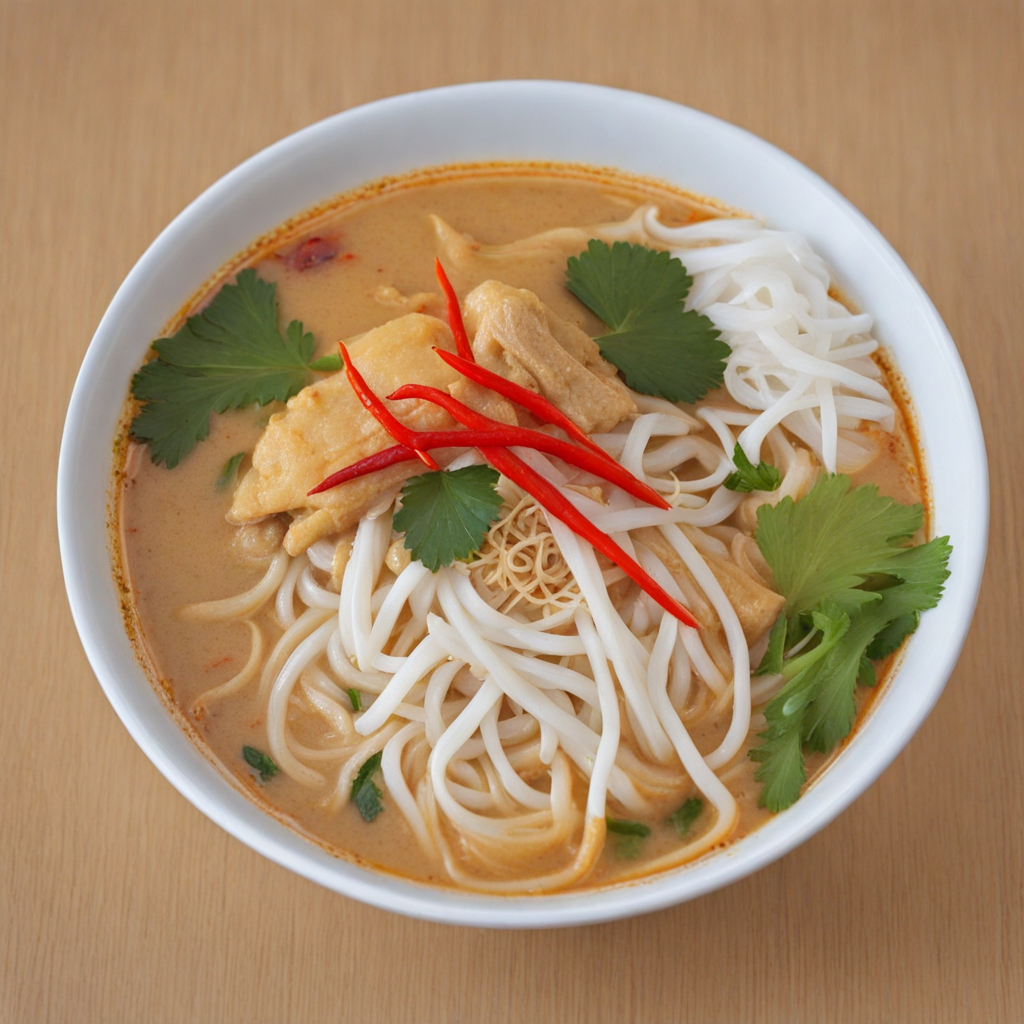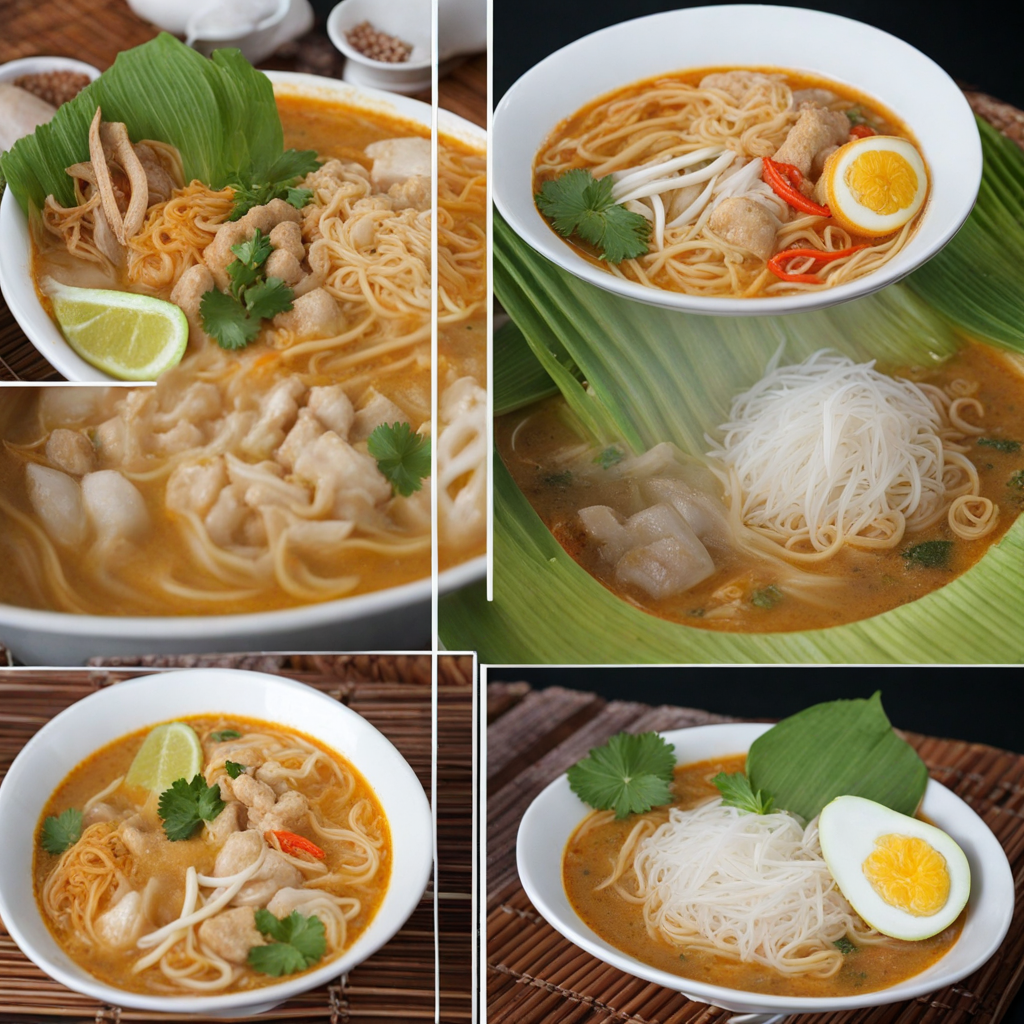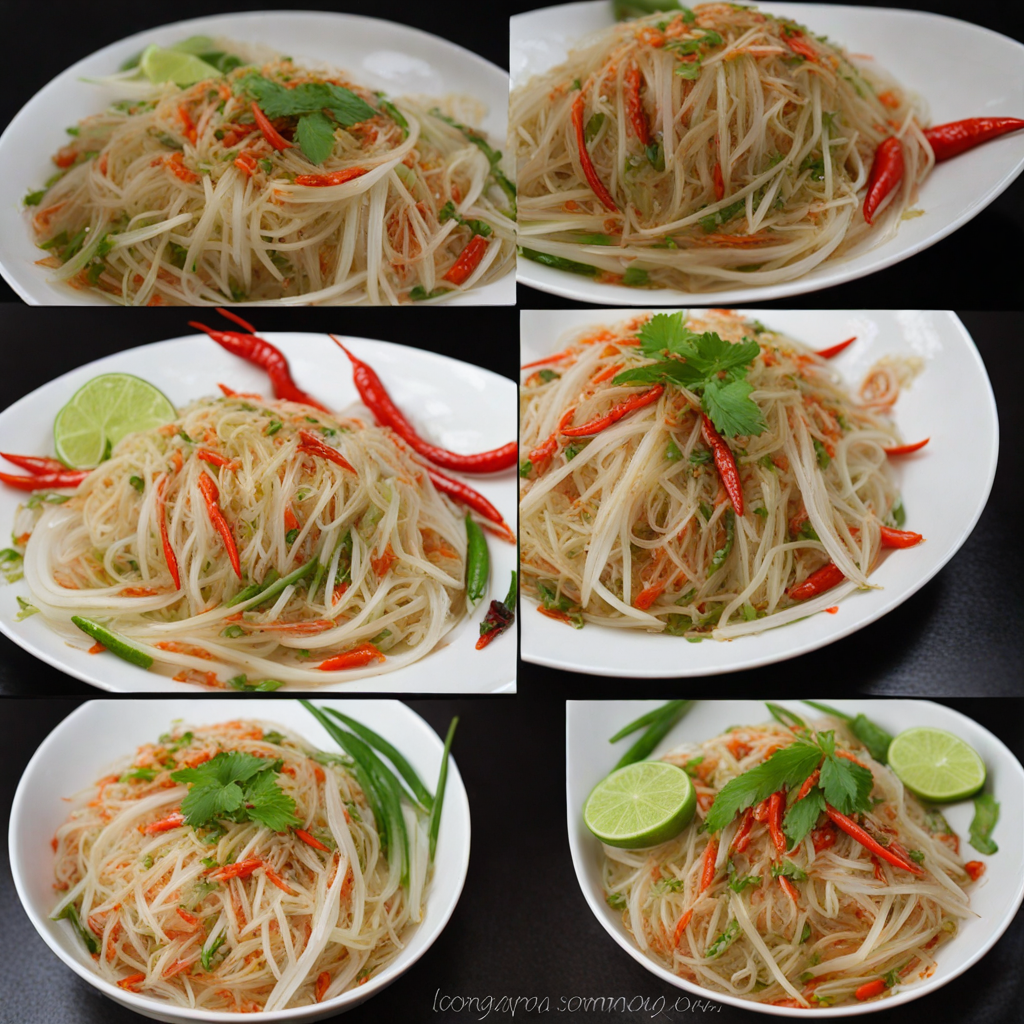Khao Poon
Khao Poon is a traditional Laotian noodle dish that offers a delightful blend of flavors and textures. The dish features rice vermicelli noodles, which are soft and slightly chewy, providing a perfect base for the rich and aromatic broth. This broth is typically made from a combination of coconut milk, fish sauce, and a variety of spices, including lemongrass, galangal, and kaffir lime leaves. The resulting flavor is a harmonious balance of creamy and savory notes, with a fragrant aroma that invites you to take your first bite. One of the standout components of Khao Poon is the use of fresh herbs and vegetables, which add brightness and freshness to the dish. Commonly included are shredded cabbage, bean sprouts, and fresh herbs like cilantro and mint. These ingredients not only enhance the visual appeal but also contribute to the overall taste experience, providing crunch and a refreshing counterpoint to the rich broth. Additionally, Khao Poon is often served with a side of lime wedges and chili paste, allowing diners to customize their level of acidity and spice, making each bowl uniquely suited to individual preferences. Khao Poon is often enjoyed as a communal dish, making it a popular choice for family gatherings and celebrations. Its versatility allows for various proteins to be added, such as chicken, fish, or even tofu for a vegetarian option. Whether enjoyed as a hearty meal or a flavorful snack, Khao Poon captures the essence of Laotian cuisine, showcasing the country's vibrant ingredients and culinary traditions. Each bite is a journey through the flavors of Laos, inviting you to savor and explore the rich tapestry of its culinary heritage.
How It Became This Dish
Origin of ເຂົ້າປຸ້ນ ຂອງປຸ້ນ (khao pun), a beloved dish from Laos, has its roots deeply embedded in the fertile landscapes and rich culinary traditions of Southeast Asia. The dish is primarily made from rice, which has been a staple food in Laos for centuries. Rice cultivation in Laos dates back over a thousand years, and it is intricately linked to the culture and lifestyle of the Laotian people. The term "ເຂົ້າ" (khao) translates to "rice" in Lao, while "ປຸ້ນ" (pun) refers to the way the dish is prepared, which generally involves mixing rice with various ingredients to create a flavorful and aromatic meal. The origins of khao pun can be traced back to the ancient practices of using rice as a base for different savory toppings, showcasing the agricultural abundance of the region. \n Cultural Significance Khao pun is more than just a dish; it is a cultural symbol that embodies the communal spirit of the Laotian people. Traditionally, it is served during festivals, family gatherings, and significant life events such as weddings and celebrations. This dish represents the essence of Laotian hospitality, as it is often shared among family and friends, reinforcing social bonds. The preparation of khao pun is also steeped in ritual. Families often come together to make the rice noodles from scratch, a process that can take several hours. This collaborative effort not only emphasizes the importance of community but also allows for the transmission of culinary skills and traditions from one generation to the next. The act of cooking khao pun is a celebration of life, nature, and the culinary legacy of Laos. \n Ingredients and Preparation Khao pun is traditionally made from rice flour, which is mixed with water and steamed to create soft, thin noodles. These noodles serve as the base of the dish and can be served warm or at room temperature. The versatility of khao pun lies in its toppings, which can vary significantly based on regional preferences and available ingredients. Common toppings include a variety of meats such as grilled chicken, beef, or fish, often marinated in flavorful herbs and spices. The dish is frequently accompanied by a rich coconut milk broth, which adds depth and creaminess. Fresh herbs such as mint, cilantro, and green onions are typically used as garnishes, while crunchy vegetables like bean sprouts, cabbage, and cucumber provide texture and freshness. A distinctive feature of khao pun is the use of spicy dipping sauces, such as a chili-lime sauce or a fermented fish dipping sauce known as "nam pa." These sauces enhance the overall flavor profile of the dish, providing a balance between the richness of the toppings and the freshness of the vegetables. \n Regional Variations As khao pun has evolved over time, various regional adaptations have emerged, reflecting the local ingredients and culinary practices of different areas in Laos. In the northern regions, for instance, khao pun may be served with a spicier broth, often incorporating local herbs and wild greens. Meanwhile, in the southern parts of Laos, the dish is typically accompanied by a sweeter and creamier coconut milk sauce, which gives it a unique twist. In urban centers like Vientiane and Luang Prabang, street vendors have embraced khao pun, offering quick and affordable versions of the dish to cater to the bustling lifestyle of city dwellers. These street food adaptations often feature a more simplified preparation method and a variety of toppings, allowing customers to customize their meals according to their preferences. This adaptability has contributed to khao pun's growing popularity not only within Laos but also among international food enthusiasts who are increasingly drawn to the rich flavors of Laotian cuisine. \n Influence of Globalization The globalization of food culture has also played a significant role in the evolution of khao pun. As Laotian immigrants have settled in various parts of the world, they have brought their culinary traditions with them, introducing khao pun to new audiences. In countries with significant Laotian communities, such as the United States, khao pun has been embraced by food lovers seeking authentic Southeast Asian flavors. Furthermore, the rise of food media, including cooking shows and social media platforms, has allowed for the widespread dissemination of khao pun recipes and cooking methods. This exposure has not only sparked interest in Laotian cuisine but has also encouraged chefs and home cooks alike to experiment with traditional recipes, resulting in innovative interpretations of khao pun that reflect contemporary tastes. \n Preservation of Tradition Despite the influences of globalization and modernization, efforts to preserve the traditional preparation and cultural significance of khao pun continue to thrive. Various organizations and culinary schools in Laos are dedicated to teaching young people the importance of their culinary heritage, ensuring that the traditional methods of making khao pun are passed down through generations. Additionally, local markets and food festivals celebrate the diversity of Laotian cuisine, showcasing khao pun as a centerpiece of the culinary experience. These events serve not only to promote local ingredients and flavors but also to educate visitors about the cultural significance of dishes like khao pun, fostering a deeper appreciation for Laotian gastronomy. \n Conclusion In conclusion, ເຂົ້າປຸ້ນ (khao pun) represents a rich tapestry of history, culture, and community within Laos. From its humble origins as a rice-based dish to its status as a symbol of Laotian hospitality and culinary heritage, khao pun continues to evolve while remaining deeply rooted in tradition. As its popularity spreads globally, the dish serves as a delicious reminder of the vibrant food culture of Laos, inviting all to partake in its rich and flavorful journey.
You may like
Discover local flavors from Laos







